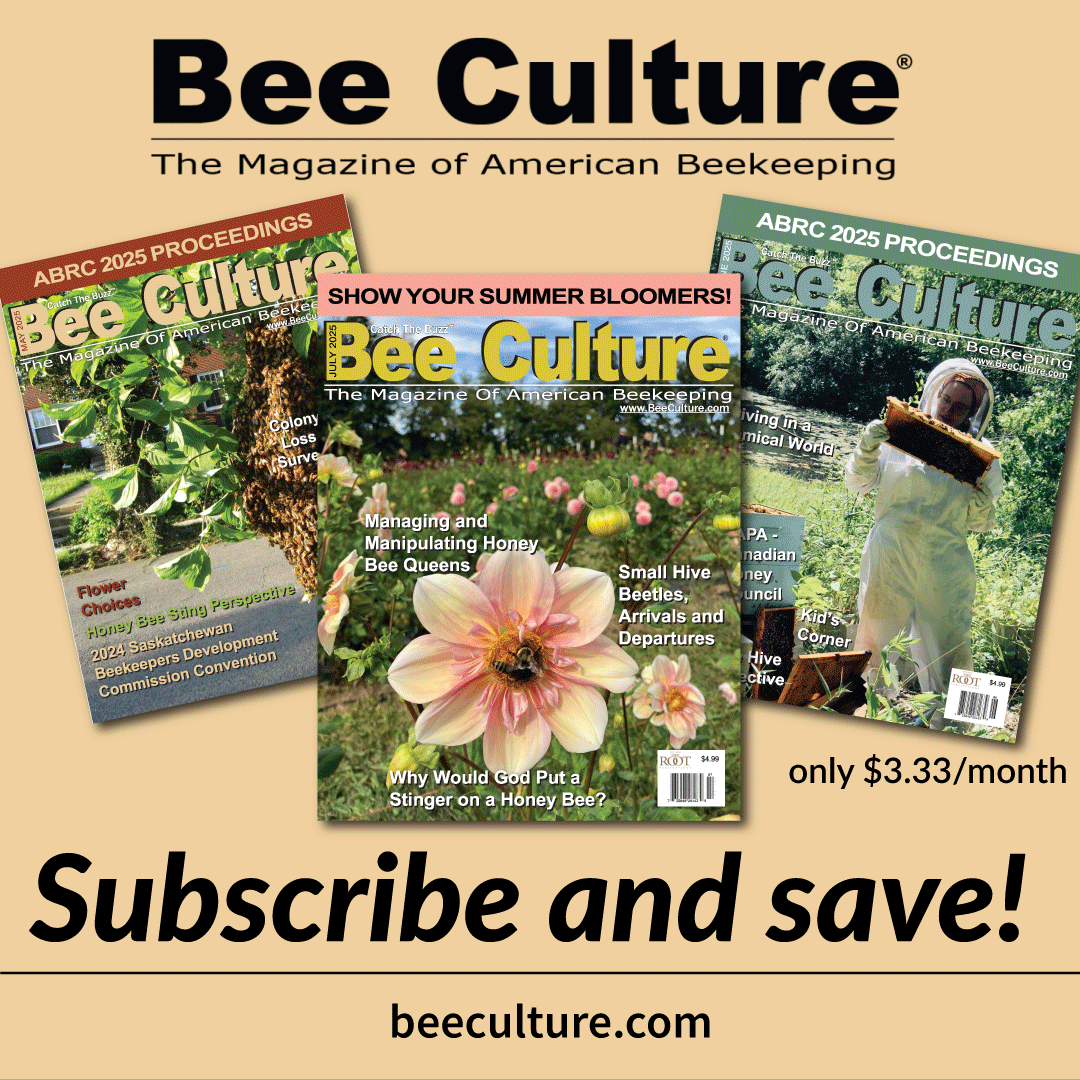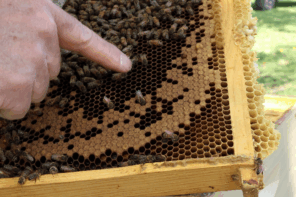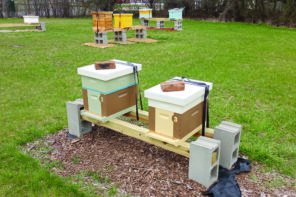By: Ross Conrad
This article originally appeared in the Summer 2020 issue of BEEKeeping Your First Three Years
Beekeeping has gotten complicated: Feeding, mites, diseases, hive beetles, wax moths, choosing an apiary location, having the right equipment on hand when you need it and a host of other issues need to be considered. One way to help get a handle on this steep learning curve as a beginner is to separate the grain from the chaff and let go of the things that you don’t need to worry about during your first year. Here are eight common worries most first-year beekeepers can safely ignore.
1. Harvesting honey
Yeah, honey is one of the sweet rewards of beekeeping. Nevertheless, in their first year, most colonies in your average apiary are not going to produce a much if any surplus of honey that can be safely harvested without creating a shortage of honey in the hive and the potential for colony starvation during Winter. Plan on not harvesting honey your first year. You can put off spending money on an extractor and other harvesting tools and equipment which are expensive and help ensure the bees have enough honey to get them through ’till Spring at the same time.
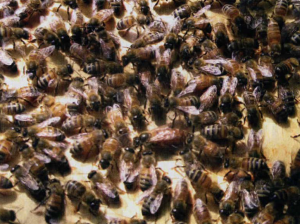
Identifying the queen among thousands of workers is like looking for a moving needle in a haystack. Difficult and not necessary if you know what to look for in the brood nest.
2. Crushing bees
I get it. Folks get bees in order to help them thrive and so there is a strong reluctance to allow any bee to get injured or crushed. It’s important to remember that a honey bee colony is a super organism. A single individual made up of many parts. Each bee in the hive is like a cell in your body. Every day many of your cells die, and your body creates many replacement cells. The same thing happens with bees in a bee hive. Just as you can safely donate a pint of blood or a kidney and continue a healthy productive life, you do not need to worry about crushing a dozen or so bees when checking on and managing your hive. The one exception to this of course is the queen. You do not want to accidentally crush or injure royalty.
3. Burr comb
Burr comb is the beeswax a colony will build inside the hive that is not neatly surrounding by the four sides of each frame. Unless the burr comb is in the way and preventing you from performing a hive manipulation, such a installing a mite treatment, this excess comb does not need to be removed. Besides, it is a lot easier to clean the burr comb off frames when there are no bees crawling all over them. Wait until the equipment is off the hive and clear of bees to remove the burr comb from the frames, supers and hive bodies. And don’t forget to collect all this wax so you can melt it down, clean it and put it to good use or at least give it to someone else who can use it.
4. The drone population
Drones, the male honey bee, does no work within the hive. Drones don’t have stingers to defend the hive. They don’t build comb, forage for pollen or nectar, or feed the brood. It is well established that it is the female worker bees that do all the hive work and make all the honey. As a result, sometimes a beginner beekeeper will get worried when they start to see a lot of drones or drone brood in their hive. Just as a colony needs to be queenright, during the swarming season, a colony needs to be drone-right. Don’t be worried about many drones in your hives. Do not even be worried about a lot of drone brood unless accompanied by very little to no worker brood, in which case it may mean that the colony is a drone layer and needs a new queen.
5. Spotting the queen
You want to make sure your colonies have a fertile, laying queen. However, making sure hives are queen-right has little to do with actually seeing the queen. Mostly you should be looking for the signs that prove a colony is queen-right: large patches of capped worker brood and normal looking unhatched eggs. Spotting the queen amongst the many workers can be exciting but it does nothing to tell you if she is up to the job of leading the colony toward a fruitful and prosperous future.
6. Comb color
While freshly built comb has an off-white/pale yellow color, comb will darken over time. Pigments from pollen and propolis will cause the comb to become a dark yellow, while generations of brood raised in the comb will turn the comb a dark brown. Over time the comb may become so dark it will eventually turn black. More and more, old comb is recognized as a potential liability to honey bee colonies, as it tends to contain elevated levels of disease, chemical and pesticide residues. A diligent beekeeper will want to weed out the old combs in their hives. This means removing the combs that a nucleus colony comes with, and not using old combs from former beekeepers that have gotten out of the business.
In their first year however, a nascent colony will need every bit of drawn comb they can get to help them build up and prepare for Winter in time. It is better not to worry about removing old combs during a colony’s first year and wait until its second year to start rotating old combs out of your colonies.
Unfortunately, comb color is not a very reliable indicator of comb age. Brood comb that is only a year or two old can be very dark because of brood consistently raised in it. It is best to use some kind of system to track the age of all frames of drone comb in the hive and work on removing combs of unknown age as soon as reasonably possible.
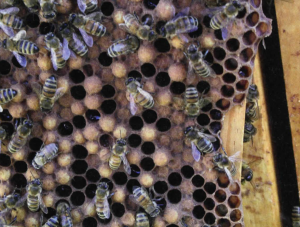
As long as the brood is found in consistent patches and most of the brood is worker brood, finding large amounts of drone brood in hives is normal during the swarming season and not something to worry about. If the majority of the brood is drone brood, or the drone brood is not found in consistent patches and inter-mixed with worker brood as shown here, then there is a problem.
7. Too many bees in the hive at the end of Summer
By the end of Summer a healthy colony should be crowded with lots of bees. This can create anxiety on the part of the beginning beekeeper worried about swarming and having too many mouths to feed through the a long, cold Winter. By the end of Summer as temperatures get cooler and forage less abundant, most colonies will tend to resist the urge to swarm. Since the major nectar flows are over and the beekeepers efforts turn to getting colonies prepared for Winter, adding supers of empty comb or foundation is not a good idea at this time. It is typically better to let the bees crowd the hive and pack in the last of the honey flow so the colony has plenty to eat. A large healthy population of bees occupying the hive as it heads into Winter will have an easier time raising Winter young and absorbing the loss of the older bees as they die off during the Winter dearth. They will also have an easier time keeping each other warm during a blast of cold air from an arctic vortex.
8. Disturbing the bees
Many beginner beekeepers worry about bothering the bees too much and preventing their colonies from doing their work and staying healthy. This fear of disturbing the bees combined with the natural intimidation a novice beekeeper will feel about being in the middle of thousands of stinging insects is fertile ground to rationalize the need to leave the bees alone. Unfortunately, this is not a good idea especially for the beginner.
Opening the hive is the only way to be sure the colony is queen-right, disease and pest free and has enough food to prevent starvation. The first-year beekeeper also needs all the practice they can get, opening hives, using their smoker and hive tool, observing the inner working of a colony so they can readily recognize the difference between healthy bees and sick bees, etc. Claims that a honey bee colony takes days to recover from the disturbance created when a beekeeper smokes a colony, opens the hive and removes combs for inspection is nonsense. Unless the queen is accidentally injured or killed, a colony will be back to its usual routine within 15 minutes to half an hour after being closed back up. Less if your talent as a keeper of bees is advanced. Do not let the fear of disturbing the bees keep you from getting the important experience you need to become a successful and skilled beekeeper.





